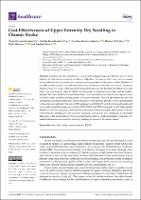Por favor, use este identificador para citar o enlazar este ítem:
https://repositorio.usj.es/handle/123456789/759
Registro completo de metadatos
| Campo DC | Valor | Lengua/Idioma |
|---|---|---|
| dc.contributor.author | Fernandez-Sanchis, Daniel | - |
| dc.contributor.author | Brandín de la Cruz, Natalia | - |
| dc.contributor.author | Jiménez Sánchez, Carolina | - |
| dc.contributor.author | Gil-Calvo, Marina | - |
| dc.date.accessioned | 2022-03-25T11:58:12Z | - |
| dc.date.available | 2022-03-25T11:58:12Z | - |
| dc.date.issued | 2022-01-14 | - |
| dc.identifier.citation | Fernández-Sanchis, D.; Brandín-de la Cruz, N.; Jiménez-Sánchez, C.; Gil-Calvo, M.; Herrero, P.; Calvo, S. Cost-Effectiveness of Upper Extremity Dry Needling in Chronic Stroke. Healthcare 2022, 10, 160. https://doi.org/10.3390/healthcare10010160 | es_ES |
| dc.identifier.issn | 2227-9032 | es_ES |
| dc.identifier.uri | https://repositorio.usj.es/handle/123456789/759 | - |
| dc.description.abstract | Introduction: Dry needling is a non-pharmacological approach that has proven to be effective in different neurological conditions. Objective: The aim of this study was to evaluate the cost-effectiveness of a single dry needling session in patients with chronic stroke. Methods: A cost-effectiveness analysis was performed based on a randomized controlled clinical trial. The results obtained from the values of the EuroQol-5D questionnaire and the Modified Modified Ashworth Scale were processed in order to obtain the percentage of treatment responders and the quality-adjusted life years (QALYs) for each alternative. The cost analysis was that of the hospital, clinic, or health center, including the equipment and physiotherapist. The cost per respondent and the incremental cost-effectiveness ratio of each alternative were assessed. Results: Twenty-three patients with stroke were selected. The cost of DN treatment was EUR 14.96, and the data analysis showed a favorable cost-effectiveness ratio of both EUR/QALY and EUR/responder for IG, although the sensitivity analysis using limit values did not confirm the dominance (higher effectiveness with les cost) of the dry needling over the sham dry needling. Conclusions: Dry needling is an affordable alternative with good results in the cost-effectiveness analysis—both immediately, and after two weeks of treatment—compared to sham dry needling in persons with chronic stroke | es_ES |
| dc.format.extent | 11 p. | es_ES |
| dc.format.mimetype | application/pdf | es_ES |
| dc.language.iso | eng | es_ES |
| dc.publisher | MDPI | es_ES |
| dc.rights | Atribución 4.0 Internacional | * |
| dc.rights.uri | http://creativecommons.org/licenses/by/4.0/ | * |
| dc.subject | Cost–utility | es_ES |
| dc.subject | Stroke | es_ES |
| dc.subject | Upper extremity | es_ES |
| dc.subject | EQ-5D | es_ES |
| dc.title | Cost-Effectiveness of Upper Extremity Dry Needling in Chronic Stroke | es_ES |
| dc.type | journal article | es_ES |
| dc.identifier.doi | https://doi.org/10.3390/healthcare10010160 | es_ES |
| dc.rights.accessRights | open access | es_ES |
| Aparece en las colecciones: | Artículos de revistas | |
Ficheros en este ítem:
| Fichero | Descripción | Tamaño | Formato | |
|---|---|---|---|---|
| Cost-Effectiveness of Upper Extremity Dry Needling in Chronic Stroke.pdf | 14,41 MB | Adobe PDF |  Visualizar/Abrir |
Este ítem está sujeto a una licencia Creative Commons Licencia Creative Commons

